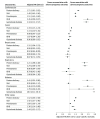Adverse Pregnancy Outcomes and Long-Term Mortality in Women
- PMID: 38619848
- PMCID: PMC11019441
- DOI: 10.1001/jamainternmed.2024.0276
Adverse Pregnancy Outcomes and Long-Term Mortality in Women
Abstract
Importance: Women with adverse pregnancy outcomes, such as preterm delivery or preeclampsia, have higher future risks of cardiometabolic disorders; however, little is known about their long-term mortality risks. A better understanding of such risks is needed to facilitate early identification of high-risk women and preventive actions.
Objective: To determine long-term mortality risks associated with 5 major adverse pregnancy outcomes in a large population-based cohort of women.
Design, setting, and participants: This national cohort study in Sweden used the Swedish Medical Birth Register, containing prenatal and birth information for nearly all deliveries in Sweden since 1973, to identify women who had a singleton delivery during 1973 to 2015. All 2 195 667 such women with information for pregnancy duration and infant birth weight were included in the study. Data were analyzed from March to September 2023.
Exposure: Adverse pregnancy outcomes (preterm delivery, small for gestational age, preeclampsia, other hypertensive disorders, and gestational diabetes), identified from nationwide birth records.
Main outcome and measures: All-cause and cause-specific mortality through December 31, 2018. Cox regression was used to compute hazard ratios (HRs) for mortality associated with specific adverse pregnancy outcomes, adjusted for other maternal factors. Cosibling analyses assessed for confounding by shared familial (genetic or environmental) factors.
Results: In 56 million person-years of follow-up to a median (IQR) age of 52 (42-61) years, 88 055 women (4%) died (median [IQR] age at death, 59 [50-67] years). All 5 adverse pregnancy outcomes were independently associated with increased mortality. Across the entire follow-up (≤46 years after delivery), adjusted HRs for all-cause mortality associated with specific adverse pregnancy outcomes were as follows: gestational diabetes, 1.52 (95% CI, 1.46-1.58); preterm delivery, 1.41 (95% CI, 1.37-1.44); small for gestational age, 1.30 (95% CI, 1.28-1.32); other hypertensive disorders, 1.27 (95% CI, 1.19-1.37); and preeclampsia, 1.13 (95% CI, 1.10-1.16). All HRs remained significantly elevated even 30 to 46 years after delivery. These effect sizes were only partially (0%-45%) reduced after controlling for shared familial factors in cosibling analyses. Women who experienced multiple adverse pregnancy outcomes had further increases in risk. Several major causes of death were identified, including cardiovascular and respiratory disorders and diabetes.
Conclusions and relevance: In this large national cohort study, women who experienced any of 5 major adverse pregnancy outcomes had increased mortality risks that remained elevated more than 40 years later. Women with adverse pregnancy outcomes need early preventive evaluation and long-term follow-up for detection and treatment of chronic disorders associated with premature mortality.
Conflict of interest statement
Figures


References
-
- Fraser A, Nelson SM, Macdonald-Wallis C, et al. . Associations of pregnancy complications with calculated cardiovascular disease risk and cardiovascular risk factors in middle age: the Avon Longitudinal Study of Parents and Children. Circulation. 2012;125(11):1367-1380. doi:10.1161/CIRCULATIONAHA.111.044784 - DOI - PMC - PubMed
MeSH terms
Grants and funding
LinkOut - more resources
Full Text Sources

